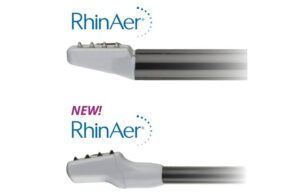
Aerin Medical announced today that it received FDA 510(k) clearance and launched its next-generation RhinAer stylus.
Sunnyvale, California-based Aerin designed the system as a non-invasive, temperature-controlled radiofrequency technology. It treats the causes of rhinorrhea (runny nose), post-nasal drip and congestion associated with chronic rhinitis in a single session.
The new RhinAer provides physicians with improved visualization, easier access and tissue apposition. Aerin said in a news release that this is especially helpful in patients with narrow nasal airways.
“The new RhinAer stylus gives me confidence that I can access and treat the posterior nasal nerve area more effectively,” said Dr. Randall Ow, otolaryngologist at Sutter Health in Sacramento and the first physician in the world to use the device on a patient. “This newer generation RhinAer allows me to confidently treat multiple target areas, in the office setting, even in very challenging anatomy.”
Aerin modified its lower-profile stylus for RhinAer with a slimmer shaft and tip. The company said this improves visualization and access with the device. Its tip also tilts backward by 10 degrees with a more malleable shaft for easier tissue apposition.
“Aerin Medical relentlessly strives to meet the needs of physicians and their patients,” said CEO Matt Brokaw. “We listened closely to the otolaryngology community in developing the new RhinAer. Based upon our discussions, rigorous testing and physician feedback, we are confident that the next-generation RhinAer stylus enhancements will be well-received.”
Proven quality
Results from a clinical trial published in July demonstrated that chronic rhinitis symptoms continued to improve through 12 months after treatment with RhinAer. The study showed that 88.2% of patients positively responded to RhinAer treatment at 24 months.
Findings build on previous data demonstrating superiority and safety with RhinAer compared to a sham procedure control. Two-year data published in June backed the temperature-controlled radiofrequency (RF) technology as well.